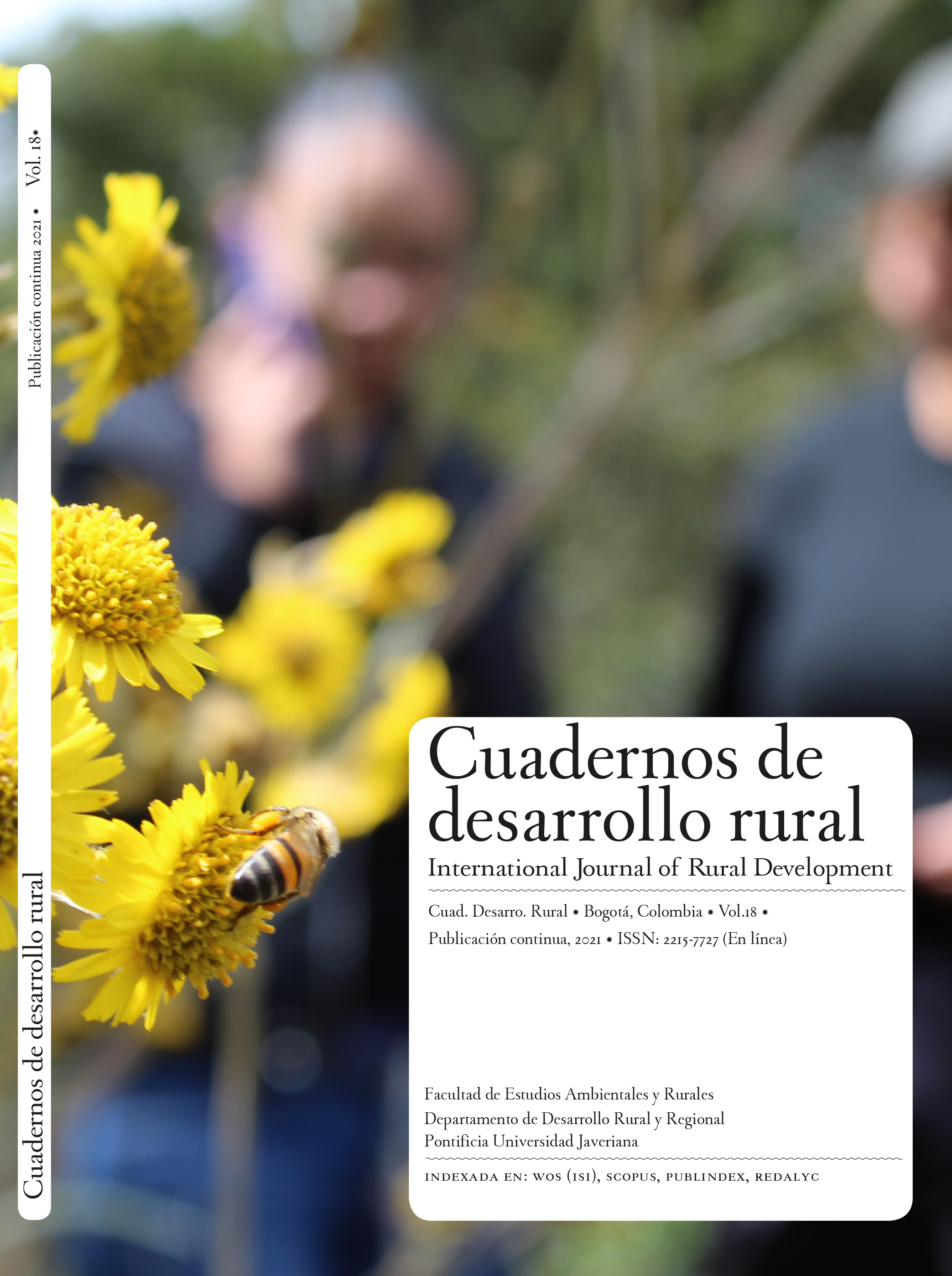Resumen
This study aimed to determine the effect of the socio-economic factors on climate change adaptation strategy of white pepper farmers in Bangka-Belitung Province, Indonesia. West Bangka Regency was chosen as a research site because this area is one of the main producer areas of white pepper. Then, 70 samples of white pepper farmers were randomly selected. The cross-section primary data were collected through interviewed directly with farmers in the research location using a list of questions in the questionnaire which had been served by the researcher. The logit regression model was used to analyze factors influencing farmers' adaptation to climate change. This research suggested as follows: 1) government programmes related to accelerating the implementation of climate change adaptation should be prioritized to female farmers 2) knowledge and technical skill of extension agent at local level relate to implementing adapted strategies of climate change must be increased, as well as materials regarding the implementation of climate change adaptation should be part of the agricultural extension syllabus for white pepper farmers.
Alauddin, M., & Sarker, M. A. R. (2014). Climate change and farm-level adaptation decisions and strategies in drought-prone and groundwater-depleted areas of Bangladesh: An empirical investigation. Ecological Economics, 106, 204–213. https://doi.org/10.1016/j.ecolecon.2014.07.025
Asfaw, A., Simane, B., Hassen, A., & Bantider, A. (2017). Determinants of non-farm livelihood diversification: evidence from rainfed-dependent smallholder farmers in northcentral Ethiopia ( Woleka sub-basin). Development Studies Research, 4(1), 22–36. https://doi.org/10.1080/21665095.2017.1413411
Below, T. B., Mutabazi, K. D., Kirschke, D., Franke, C., Sieber, S., Siebert, R., & Tscherning, K. (2012). Can farmers’ adaptation to climate change be explained by socio-economic household-level variables? Global Environmental Change, 22(1), 223–235. https://doi.org/10.1016/j.gloenvcha.2011.11.012
Bhaktikul, K. (2012). State of Knowledge on Climate Change and Adaptation Activities in Thailand. Procedia - Social and Behavioral Sciences, 40, 701–708. https://doi.org/10.1016/j.sbspro.2012.03.252
Bryan, E., Ringler, C., Okoba, B., Roncoli, C., Silvestri, S., & Herrero, M. (2013). Adapting agriculture to climate change in Kenya: Household strategies and determinants. Journal of Environmental Management, 114, 26–35. https://doi.org/10.1016/j.jenvman.2012.10.036
Candradijaya, A. (2015). Farmer adaptive capacity to climate change in strengthening rice sufficiency in Sumedang Regency , West Java province. Doctoral thesis. Bogor Agricultural University, Indonesia.
Carter, M. R., & Barrett, C. B. (2006). The economics of poverty traps and persistent poverty: An asset-based approach. Journal of Development Studies, 42(2), 178–199. https://doi.org/10.1080/00220380500405261
Ehiakpor, D. S., Danso-Abbeam, G., & Baah, J. E. (2016). Cocoa farmer���s perception on climate variability and its effects on adaptation strategies in the Suaman district of western region, Ghana. Cogent Food & Agriculture, 2(1). https://doi.org/10.1080/23311932.2016.1210557
Festiani, R. A. (2011). Dampak Perubahan Iklim Terhadap Pendapatan dan Faktor-Faktor Penentu Adaptasi Petani Terhadap Perubahan Iklim : Studi Kasus di Desa Kemukten, Kecamatan Kersana, Kabupaten Brebes. Under graduate Thesis. Bogor Agricultural University, Indonesia.
Füssel, H. M. (2007). Adaptation planning for climate change: Concepts, assessment approaches, and key lessons. Sustainability Science, 2(2), 265–275. https://doi.org/10.1007/s11625-007-0032-y
Gujarati, D. (2004). Basic Econometrics (fourth ed.). The McGraw-HillCompanies.
Kassam, A., & Friedrich, T. (2012). An ecologically sustainable approach to agricultural production intensification : Global perspectives and developments An ecologically sustainable approach to agricultural p roduction intensification : Global perspectives and developments 1. Field Actions Science Reports, 1(6), 1–7. https://doi.org/10.1201/9781315365800
Kurniawati, F. (2011). Dampak perubahan iklim terhadap pendapatan dan faktor-faktor penentu adaptasi petani terhadap perubahan iklim : Studi Kasus di Desa Purwasari , Kecamatan Dramaga. Undergraduate Thesis. Bogor Agricultural University, Indonesia.
Menike, L. M. C. S., & Arachchi, K. A. G. P. K. (2016). Adaptation to Climate Change by Smallholder Farmers in Rural Communities: Evidence from Sri Lanka. Procedia Food Science, 6(Icsusl 2015), 288–292. https://doi.org/10.1016/j.profoo.2016.02.057
Ministry of Agriculture Republic of Indonesia. (2016). Agricultural Statistics 2016.
Nasir, G. (2013). Peningkatan produksi, produktivitas dan mutu tanaman rempah dan penyegar. Jakarta: Direktorat Jenderal Perkebunan Kementerian Pertanian.
Rejekiningrum, P., Las, I., Amien, I., & Pujilestari, N. (2011). Agriculture Sector Adaptation to Climate Change (Adaptasi Perubahan Iklim Sektor Pertanian). Badan Penelitian dan Pengembangan Pertanian, Kementerian Pertanian.
Roco, L., Engler, A., Bravo-Ureta, B., & Jara-Rojas, R. (2014). Farm level adaptation decisions to face climatic change and variability: Evidence from Central Chile. Environmental Science and Policy, 44, 86–96. https://doi.org/10.1016/j.envsci.2014.07.008
Rurinda, J., Mapfumo, P., van Wijk, M. T., Mtambanengwe, F., Rufino, M. C., Chikowo, R., & Giller, K. E. (2014). Sources of vulnerability to a variable and changing climate among smallholder households in Zimbabwe: A participatory analysis. Climate Risk Management, 3, 65–78. https://doi.org/10.1016/j.crm.2014.05.004
Singh, C., Dorward, P., & Osbahr, H. (2016). Developing a holistic approach to the analysis of farmer decision-making: Implications for adaptation policy and practice in developing countries. Land Use Policy, 59, 329–343. https://doi.org/10.1016/j.landusepol.2016.06.041
Smit, B., & Wandel, J. (2006). Adaptation, adaptive capacity and vulnerability. Global Environmental Change, 16(3), 282–292. https://doi.org/10.1016/j.gloenvcha.2006.03.008
Sukartini, N. M., & Solihin, A. (2013). Respon Petani terhadap Perkembangan teknologi dan Perubahan Iklim : studi Kasus Subak di Desa Gadungan , tabanan , Bali. Jurnal Ekonomi Kuantitatif Terapan/Jekt, 6(2), 128–139.
Tambo, J. A. (2016). Adaptation and resilience to climate change and variability in north-east Ghana. International Journal of Disaster Risk Reduction, 17, 85–94. https://doi.org/10.1016/j.ijdrr.2016.04.005
Tripathi, A., & Mishra, A. K. (2017). Knowledge and passive adaptation to climate change: An example from Indian farmers. Climate Risk Management, 16, 195–207. https://doi.org/10.1016/j.crm.2016.11.002
Widiyanti, W., & Dittmann, A. (2014). Climate Change and Water Scarcity Adaptation Strategies in the Area of Pacitan, Java Indonesia. Procedia Environmental Sciences, 20, 693–702. https://doi.org/10.1016/j.proenv.2014.03.083
Wood, S. A., Jina, A. S., Jain, M., Kristjanson, P., & DeFries, R. S. (2014). Smallholder farmer cropping decisions related to climate variability across multiple regions. Global Environmental Change, 25(1), 163–172. https://doi.org/10.1016/j.gloenvcha.2013.12.011

Esta obra está bajo una licencia internacional Creative Commons Atribución 4.0.
Derechos de autor 2021 Andi Irawan


